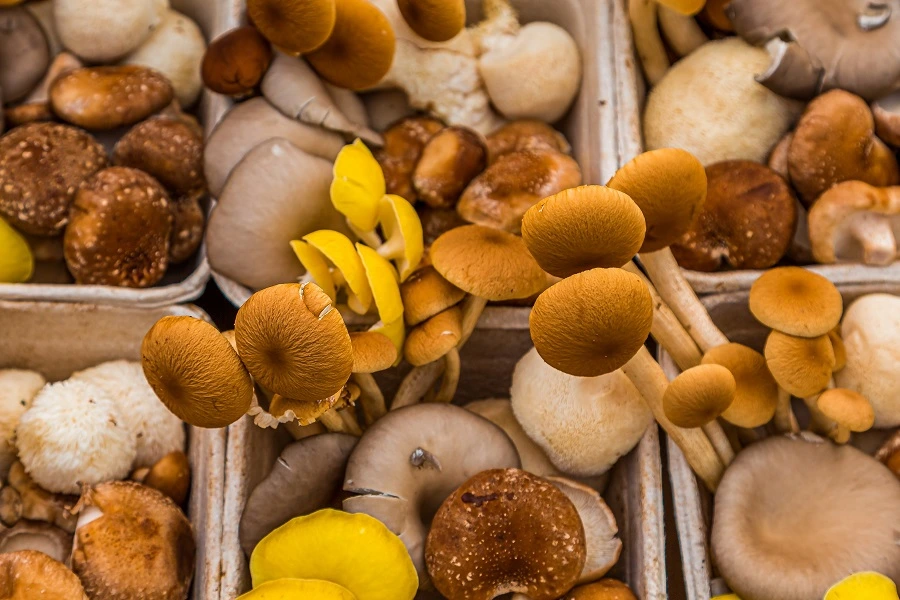Functional Mushroom Council: US producers unite on standards and transparency
Key takeaways
- US growers and suppliers have formed the Functional Mushroom Council to unify standards and improve transparency in the fast-growing functional mushroom industry.
- The council is developing shared definitions and validated testing methods to address quality concerns and clarify the mycelium–fruiting body debate.
- Rising demand and AI-driven cultivation are expected to push functional mushrooms further into mainstream food and nutrition markets.
A coalition of mushroom growers, suppliers, and brands has joined forces to form the Functional Mushroom Council (FMC) — a non-profit hailed as a “unified voice” for the rapidly expanding functional mushroom industry in North America.
FMC, which made its debut at SupplySide Global last month, aims to establish unified standards, promote scientific rigor, and enhance transparency in the functional mushroom market, which reportedly surpassed US$1.6 billion in 2023 and is projected by FMC to reach up to US$2.2 billion by the end of this year.
The association’s formation follows consumer watchdogs questioning the efficacy of the proposed health benefits of functional mushrooms, while F&B innovators explore their incorporation in functional food and beverages.
The demand for functional ingredients in the US has surged in recent years. Nearly 57% of consumers say they believe that products with natural ingredients are healthier, with active mushrooms an emerging category, indicates Innova Market Insights data.
FMC was founded by leading functional mushroom firms in the US, including Washington-based Fungi Perfecti, Nevada-based Aloha Medicinals and M2 Ingredients, Monterey Mushrooms, Mycopia, and Far West Fungi based in California. In 2026, the coalition plans to publish research showing that North American-grown mushrooms deliver stronger, more consistent benefits than imported ingredients.

Food Ingredients First speaks with Dr. Julie Daoust, chair and co-founder of the FMC and chief science officer of M2 Ingredients, about the council’s standards work, the full-spectrum debate, and the emerging technologies reshaping the next phases in functional mushroom innovation.
What steps is FMC taking to establish quality, testing, and nomenclature guidelines?
Daoust: We are establishing a common nomenclature — clear definitions for fruiting body, mycelium, primordia, substrate, and full-spectrum ingredients — because aligned terminology is foundational for regulators, brands, and consumers. In parallel, we’re developing quality and testing methods and guidelines for identity, purity, and quantitative assessment of key bioactive classes.
We are also leading multi-stakeholder workstreams across growers, analytical labs, and academic partners to validate testing methods to build frameworks for transparent labeling.
As chair of FMC and co-chair of the AOAC Botanical Ingredients and Dietary Supplement Integrity initiative on Functional Mushrooms, I am helping lead a coordinated effort to modernize the testing of functional mushroom ingredients and products.
 Mushroom coffee is one of the biggest drivers of the US functional mushroom market, projected to maintain double-digit growth through 2030.
Mushroom coffee is one of the biggest drivers of the US functional mushroom market, projected to maintain double-digit growth through 2030.
What misconceptions about functional mushrooms persist among consumers?
Daoust: One of the most persistent misconceptions is the idea that “only the fruiting body is functional.” This narrative has been repeated for years, often as a marketing tactic rather than a reflection of current science. Today, that talking point is outdated and increasingly misleading. Modern research conducted by North American growers, universities, and research institutions clearly demonstrates that mycelium-based products also have a wide spectrum of functional benefits.
Unfortunately, the “fruiting body only” message continues to create unnecessary fear and confusion in the marketplace. To counter this, FMC is compiling and publishing a growing body of end-product and mechanistic research validating full-spectrum benefits, and partnering with universities, research institutions, dietitians, and formulators to deliver clear, evidence-based education.
Why has the “mycelium versus fruiting body” debate become so central?
Daoust: FMC celebrates the diversity of functional mushroom products found on the market. Research supports the use of both mycelium and fruiting body-based products, and we do not believe this “debate” should be central to the conversation on functional mushrooms, and should focus on speaking to the benefits of functional mushrooms overall. It stems from legacy companies using traditional usage as the basis for modern consumption.
Traditionally, only the fruiting body was available for harvest, the mycelium being locked in the substrate (the wood or soil the mycelium was growing in). There were a few exceptions to that, such as Chaga being consumed as mycelium along with the woody conk it formed on the tree it grew on, and Cordyceps, where the mycelium and the fruiting body were consumed with the whole insect it had infected.
The debate has become central because it affects labeling, regulatory frameworks, consumer education, and marketplace fairness. Unfortunately, it has sometimes been weaponized for competitive marketing rather than grounded in science. As FMC, our position is clear: the conversation should shift from “mycelium versus fruiting body” to accurate characterization, transparent labeling, validated testing, and scientific merit.
 Including both the mycelium and the fruiting body captures the full spectrum of functional mushrooms’ bioactive potential, says FMC chair and co-founder Dr. Julie Daoust.
Including both the mycelium and the fruiting body captures the full spectrum of functional mushrooms’ bioactive potential, says FMC chair and co-founder Dr. Julie Daoust.
Is there any functional benefit of fruiting bodies over mycelium?
Daoust: The truth is that the idea of “one part being better than the other” oversimplifies biology. In many species, such as lion’s mane, there are bioactive compounds that appear in higher concentration in the mycelium than in the fruiting body and vice versa. Conversely, the fruiting body may contain unique chemistry, such as pigments to protect the fungal tissues from sun rays. For applications like cognitive health, gut–brain axis support, and prebiotic activity, the scientific evidence now shows that including both the mycelium and the fruiting body captures the full spectrum of bioactive potential.
The real difference in efficacy between fungal ingredients would come from the processing conditions of the fungal species. For example, if you are formulating a product to support cognitive health using lion’s mane using a whole mushroom ingredient, a water:ethanol dual extract or an ethanol extract would be important since the nootropic compounds found in lion’s mane are poorly soluble in water. A lion’s mane water extract would be appropriate for a product to support immune health since it would contain polysaccharides, but likely would have little to no impact on cognitive health.
What emerging technologies are reshaping the sector?
Daoust: The most transformative technologies are those enabling us to grow the most efficacious, standardized, and high-quality functional mushrooms at scale in North America. Solid-state fermentation cultivation systems, supported by AI-driven environmental control, now allow growers to fine-tune humidity, airflow, nutrient availability, and light cycles with extraordinary accuracy. This level of control produces consistent expression of key bioactives, reduces batch variability, and ensures that every crop meets stringent identity and purity standards.
Metabolomics is another game-changer. High-resolution chemical profiling gives us a real-time understanding of how strain genetics, substrate choices, and growth conditions influence bioactive composition. When combined with modern strain-selection tools, including genomic screening and phenotype mapping, we can intentionally cultivate mushrooms with optimized neurotrophic, immunomodulatory, or prebiotic activity.
Where do you see the functional mushroom category heading in the next five years?
Daoust: We’re entering a period of rapid maturation driven by science, consumer demand, and global health trends. Scientifically, I expect major advances in metabolomics, strain-level characterization, and microbiome-modulated mechanisms of action. Commercially, brands will increasingly adopt traceable, North American-grown ingredients to meet retailer expectations around quality and sustainability. Functional mushrooms will move from niche supplements into mainstream food, beverage, and clinical nutrition applications.
Culturally, I believe mushrooms will follow a trajectory similar to that of probiotics: once misunderstood, they are now essential in wellness conversations. We’ll see greater differentiation between culinary, adaptogenic, and clinically validated species; more informed consumers; and stronger guardrails against misinformation.
 FMC aims to pivot the conversation of “mycelium versus fruiting body” toward clear characterization, transparent labeling, and validated testing.
FMC aims to pivot the conversation of “mycelium versus fruiting body” toward clear characterization, transparent labeling, and validated testing.











